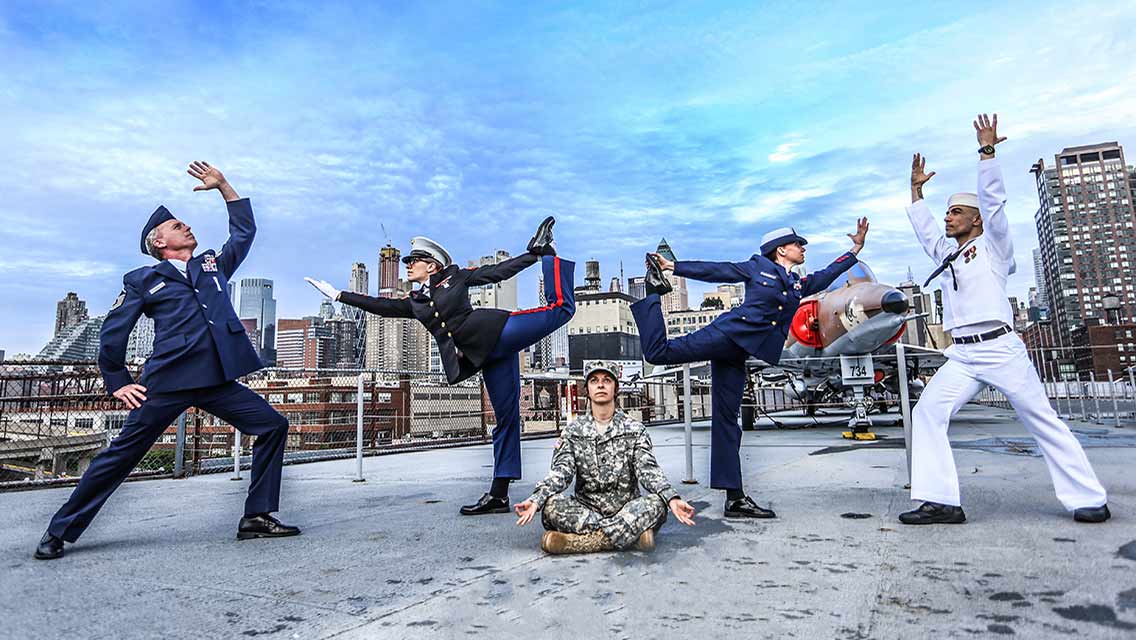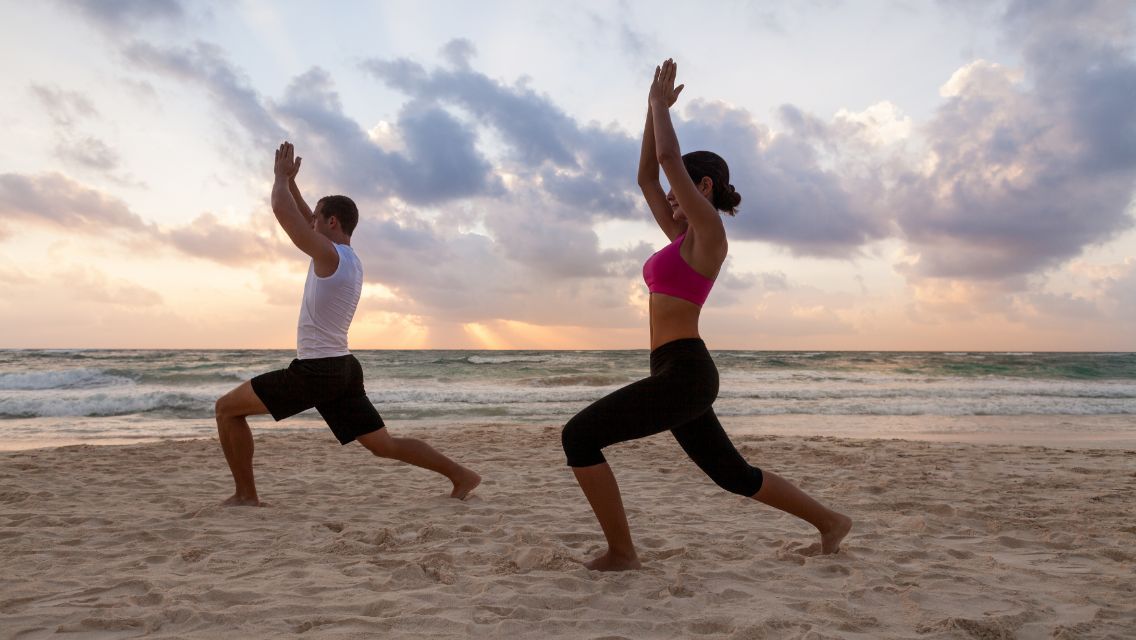While working with military veterans at the West Haven Veterans Affairs Medical Center in West Haven, Conn., Daniel J. Libby, PhD, was inspired by a client who reported that he was able to cease his sleep medications thanks to daily mindfulness practices. The vet had discovered how to move from posttraumatic stress to posttraumatic growth using “his own mind, his own breath, his own body to live and sleep in a way that brought him more ease and more joy.”
That story inspired Libby, then completing a postdoctoral fellowship at Yale University’s Department of Psychiatry, to launch the Veterans Yoga Project (VYP) in 2010, empowering past and present military members with self-regulating tools like yoga and meditation. VYP now serves more than 25,000 people through classes and other programs.
Experience Life | How did the Veterans Yoga Project come about?
Daniel J. Libby | The VA [Veterans Affairs] had just started a six-week yoga program for veterans at its outpatient clinic. It was led by an awesome teacher from the community, but of the six veterans who began the program, only one showed up on the third week. It wasn’t that the teacher was a bad teacher — he just didn’t realize he was saying and doing things that weren’t helpful for somebody recovering from trauma. I wasn’t a yoga teacher yet, but I’d spent nine summers living and working at a yoga retreat center called Feathered Pipe Ranch, where I’d seen real healing through yoga. I knew that there were ways to do this better.
I saw that, with just a few slight changes and a few points of awareness, these tools could be really effective. I partnered with another yoga teacher who was working at a different VA and created a training program for yoga teachers. We did a couple of these trainings — and here we are 10 years later!
EL | What drew you to work with military veterans and their families?
DL | I’m not a veteran myself, and most of my life I never thought about military culture — except I knew my grandfather had served, and that my uncle was killed in the Air Force in a training accident. I was maybe 4 years old when that happened, so I don’t remember my Uncle Jimmy. It wasn’t until all these years later that I realized what a trauma that was. My grandparents lost their son when he was 18. My mom lost her baby brother. Looking back, I can see the impact that had on my family.
Maybe in some indirect way that had an influence on my interest in the experience of stress and trauma and ultimately working with veterans. I was studying the psychophysiology of trauma, and if you want to study and treat trauma, you go to the VA.
EL | What makes yoga a helpful tool for people experiencing trauma?
DL | At their root, all traumatic events lack safety, predictability, and control. Think of a car accident. You’re unsafe; you can’t predict and you can’t control what your car is going to do or what the other car is going to do.
And it’s not just the external circumstances of the trauma. It’s often an unsafe, unpredictable, and uncontrolled experience in your own body and mind. You can’t predict or control how your body is going to react or what your mind is going to do in a traumatic situation. People freeze when they experience trauma. In extreme cases, they lose control of their bowels or their bladder. People do things and experience things that they didn’t train for.
The way yoga works is to help make your body, mind, and breath more safe, controlled, and predictable. With mindful breathing — take an inhalation, hold it a few seconds, let it out slowly — your breath starts to become more controllable. When you meditate, your mind becomes more predictable. With the body, it’s the same thing: When you bring attention to the physical sensations in your body, you become more predictable. You start to know yourself better. You start to be able to control how you feel sensory-wise and motor-wise, and you can move your body with more precision. The body becomes more controllable, and the body becomes more safe.
EL | How do veterans, who may have never tried meditation and yoga, make the transition from military training to mind–body training?
DL | I point out that they already know how to do what we’re teaching them. Every veteran has the experience of firing a weapon. If you learn to fire a weapon, what do you do? You put your body in a pose. You put your body in a stable position and you hold a position. Then you focus your mind on the target, the bull’s-eye. If you get distracted, you return your attention right back to where you’re aiming. You pay attention to your breath. You wait for the pause at the end of your exhalation, and that’s when you very mindfully move your finger and pull the trigger.
When you’re back in your civilian life — and this is really where I think the top therapists and peer counselors come in — you have to change your drishti, or your focused concentration. You have to find out what your values and goals for your life are now.
EL | What are the various offerings at VYP, and how can people take advantage of them?
DL | We offer more than 100 free yoga classes each week for veterans and their families through a network of teachers and studios around the country. You can contact your VYP regional director through our website, or type in your ZIP code and access teachers who have been trained by us. Our newest initiative is to develop an online yoga studio. Any veteran can go to the website and register for a live online class, whether a 15-minute breathing or meditation practice or a full hour-long yoga class — or access our whole library of classes.
We also offer a 200-hour yoga teacher training, as well as several “Mindful Resilience” training programs for healthcare workers and yoga teachers, including Mindful Resilience for Trauma Recovery. Our new Mindful Resilience for Compassion Fatigue program is designed for caregivers who experience burnout and vicarious trauma.
EL | How can non-veterans support VYP?
DL | Donate! Do a fundraiser. Or better yet come to Life Time on November 11 for our eighth annual Veterans Gratitude Week fundraiser. Your practice is done with an attitude of gratitude for our veterans and their families.
EL | What are your future goals for the program?
DL | One of our strategic initiatives is to extend more offerings to justice-involved veterans (former service members who are in the criminal-justice system), bringing yoga and meditation to veteran treatment courts. Another initiative is to work more with active-duty National Guard and with the Reserves.
We’re also looking to ensure Veterans Yoga Project is as diverse as all the veterans that we serve — a more diverse group of teachers, more diverse board of directors and staff. It’s no secret that the yoga world has, in this country, been largely white and affluent. And if we are going to support our veterans and families, we’re going to support all our veterans and families. I want to do better at making sure that we are making it a welcoming experience for everyone.
Learn more about the Veterans Yoga Project at www.veteransyogaproject.org.




